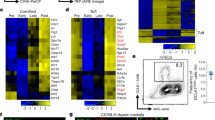Summary
Seven clonal epithelial cell lines from a thymoma of an (ACI/NMs×BUF/Mna)F1 rat and seven clonal epithelial cell lines from an ACI/NMs rat thymus were established in a medium containing 1 μM dexamethasome (DM) and were characterized cytologically. Long-term treatment of DM stabilized the epithelial nature of these epithelial cells irreversibly. The established cell lines showed a polygonal shape, were positively stained with antikeratin antiserum and had tonofilaments and desmosomes. Species of their keratin paptides were the same as those of normal thymic epithelial cells in primary cultures. The cell lines were positively stained with Th-4 monoclonal antibody which preferentially stains the medullary epithelial cells of the thymus, but not with Th-3 which preferentially stains the subcapsular and cortical epithelial cells of the thymus. The cells from the rat thymoma were much large than those from the normal thymus, as reflected in their primary cultures. No transformed phenotypes, such as high growth rate, high saturation density anchorage independency, low serum dependency and so on, were found on the cell lines from the thymoma as in the cell lines from the normal thymus by in vitro assays. DNA synthesis of the thymic lymphocytes was stimulated by culturing with a line of rat thymoma with no lectins. Thymic lymphocytes strongly bound on the cell lines from the thymoma and changed the shape of the cells. These cell lines may be useful to investigate the mechanism of thymomegenesis and the interactions between epithelial cells and thymocytes in the rat thymoma.
Similar content being viewed by others
References
Ehmann, U. K.; Shiurba, R. A.; Peterson, W. D., Jr.. Long-term proliferation of mouse thymic epithelial cells in culture. In Vitro Cell. Dev. Biol. 22:738–748; 1986.
Hirokawa, K.; Utsuyama, M.; Moriizumi, E., et al. Analysis of the thymic microenvironment by monoclonal antibodies with special reference to thymic nurse cells. Thymus 8:349–360; 1986.
Kasahara, S.; Itoh, T.; Mori, T. The effect of the supernatant of the thymic epithelial cell line, IT-45R1 (STEL), on thymocyte reactivity to mitogens. Thymus 5:115–119; 1983.
Laster, A. J.; Itoh, T.; Palker, T. J., et al The human thymic microenvironment: thymic epithelium contains specific keratins associated with early and late stages of epidermal keratinocyte maturation. Differentiation 31:67–77; 1986.
Lobach, D. H.; Itoh, T.; Singer, K. H., et al. The thymic microenvironment. Characterization of in vitro differentiation of the IT26R21 rat thymic epithelial cell line. Differentiation 34:50–59; 1987.
Lupin, D.; Iwaki, H.; Masuda, A., et al. The preferential binding of immature thymocytes to a rat thymic epithelial cell line. Thymus 14:243–259; 1989.
MacPherson, I. Agar suspension culture for quantitation of transformed cells. In: Habel, K.; Salzman, N. P., eds. Fundamental techniques in virology. New York: Academic Press; 1969:214–219.
Masuda, A.; Amo, H.; Matsuyama, M. Cytological characteristics of cultured epithelial cells from thymomas in BUF/Mna rats. Virch. Arch. [Cell Pathol.] 46:283–296; 1984.
Masuda, A.; Nishimoto, Y.; Morita, T., et al. Dexamethasone-induced changes in morphology and keratin organization of rat thymic epithelial cells in primary culture. Exp. Cell Res. 160:343–355; 1985.
Matsuura, A.; Iwaki, H.; Yuasa, H., et al. Immunological characteristics of the spontaneous thymoma in Buffalo/Mna rats. Proc. Jpn. Cancer Assoc. 43:245; 1984.
Matsuyama, M.; Yamada, C.; Hiai, H. A single dominant suscepitible gene determines spontaneous development of thymoma in BUF/Mna rat. Jpn. J. Cancer Res. (GANN) 77:1066–1068; 1986.
Matsuyama, M.; Yamada, C.; Kojima, A. Possible single dosage effects of the nude gene: suppression of spontaneous development of thymoma and nephropathy in BUF/Mnarnu/+rats. Jpn. J. Cancer Res. (GANN) 78:40–44; 1987.
Matsuyama, M.; Suzuki,H.; Yamada, H., et al. Ultrastructure of spontaneous and urethan-induced thymomas in Buffalo rats. Cancer Res. 35:2771–2779; 1975.
Nieburgs, A.C.; Korn, J. H.; Picciano, P., et al. The production of reegulatory cytokines for thymocyte proliferation by murine thymic epitheliumin vitro. Cell. Immunol. 90:426–438; 1985.
O'Farrell, P. H. High resolution two-dimensional electrophoresis of proteins. J. Biol. Chem. 250:4007–4021; 1975.
Piltch, A.; Naylor, P.; Hayashi, J. A cloned rat thymic epithelial cell line established from serum-free selective culture. In Vitro Cell. Dev. Biol. 24:289–293; 1988.
Pruss, R. M.; Mirsky, R.; Raff, M. C., et al. All classes of intermediate filaments share a common antigenic determinant defined by a monoclonal antibody. Cell 27:419–428; 1981.
Schiller, D. L.; Franke, W.W.; Geiger, B. A subfamily of relatively large and basic cytokeratin polypeptides as defined by peptide mapping is represented by one or several polypeptides in epithelial cells. EMBO J. 1:761–769; 1982.
Singer, K. H.; Wolf, L. S.; Lobach, D. F., et al. Human thymocytes bind to autologous and allogeneic thymic epithelial cellsin vitro. Proc. Natl. Acad. Sci. USA 83:6588–6592; 1986.
Taguchi, O.; Matsuyama, M. The expression site ofTsr-1 gene that provides the development of thymoma ion BUF/Mna rat. Proc. Jpn. Cancer Assoc. 48:111; 1989.
Toyokawa, T.; Hato, F.; Mazuguchi, S., et al. Remarkable changes in mitogen responsiveness and rosette-forming capacity of thymocytes with aging due to possible disorders of thymic hormone secretion from thymus epithelial cells of spontaneous thymoma BUF/Mna rats. Cell Mol. Biol. 33: 363–374; 1987.
Yasin, R.; Kundu, D.; Thompson, E. J. Preparation and characterization of cell clones from adult human dystrophic muscle. Exp. Cell Res. 138:419–422; 1982.
Author information
Authors and Affiliations
Rights and permissions
About this article
Cite this article
Akiramasuda, Ohtsuka, K. & Matsuyama, M. Establishment of functional epithelial cell lines from a rat thymoma and rat thymus. In Vitro Cell Dev Biol 26, 713–721 (1990). https://doi.org/10.1007/BF02624428
Received:
Accepted:
Issue Date:
DOI: https://doi.org/10.1007/BF02624428




